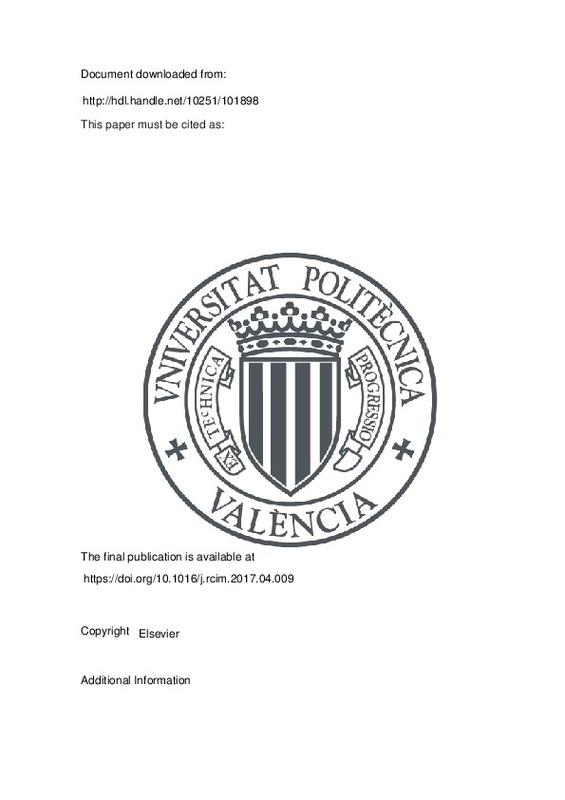JavaScript is disabled for your browser. Some features of this site may not work without it.
Buscar en RiuNet
Listar
Mi cuenta
Estadísticas
Ayuda RiuNet
Admin. UPV
On the detection of defects on specular car body surfaces
Mostrar el registro sencillo del ítem
Ficheros en el ítem
| dc.contributor.author | Molina, Jaime
|
es_ES |
| dc.contributor.author | Solanes Galbis, Juan Ernesto
|
es_ES |
| dc.contributor.author | Arnal-Benedicto, Laura
|
es_ES |
| dc.contributor.author | Tornero Montserrat, Josep
|
es_ES |
| dc.date.accessioned | 2018-05-14T04:20:59Z | |
| dc.date.available | 2018-05-14T04:20:59Z | |
| dc.date.issued | 2017 | es_ES |
| dc.identifier.issn | 0736-5845 | es_ES |
| dc.identifier.uri | http://hdl.handle.net/10251/101898 | |
| dc.description.abstract | [EN] The automatic detection of small defects (of up to 0.2 mm in diameter) on car body surfaces following the painting process is currently one of the greatest issues facing quality control in the automotive industry. Although several systems have been developed during the last decade to provide a solution to this problem, these, to the best of our knowledge, have been focused solely on flat surfaces and have been unable to inspect other parts of the surfaces, namely style lines, edges and corners as well as deep concavities. This paper introduces a novel approach using deflectometry- and vision-based technologies in order to overcome this problem and ensure that the whole area is inspected. Moreover, since our approach, together with the system used, computes defects in less than 15 s, it satisfies cycle time production requirements (usually of around 30 s per car). Hence, a two-step algorithm is presented here: in the first step, a new pre-processing step (image fusion algorithm) is introduced to enhance the contrast between pixels with a low level of intensity (indicating the presence of defects) and those with a high level of intensity (indicating the absence of defects); for the second step, we present a novel post-processing step with an image background extraction approach based on a local directional blurring method and a modified image contrast enhancement, which enables detection of defects in the entire illuminated area. In addition, the post-processing step is processed several times using a multi-level structure, with computed image backgrounds of different resolution. In doing so, it is possible to detect larger defects, given that each level identifies defects of different sizes. Experimental results presented in this paper are obtained from the industrial automatic quality control system QEyeTunnel employed in the production line at the Mercedes-Benz factory in Vitoria, Spain. A complete analysis of the algorithm performance will be shown here, together with several tests proving the robustness and reliability of our proposal. | es_ES |
| dc.description.sponsorship | This work is supported by VALi+d (APOSTD/2016/044) and PROMETEO (PROMETEOII/2014/044) Programs, both from Conselleria d'Educacio, Generalitat Valenciana. | |
| dc.language | Inglés | es_ES |
| dc.publisher | Elsevier | es_ES |
| dc.relation.ispartof | Robotics and Computer-Integrated Manufacturing | es_ES |
| dc.rights | Reconocimiento - No comercial - Sin obra derivada (by-nc-nd) | es_ES |
| dc.subject | Automated visual inspection | es_ES |
| dc.subject | Image fusion | es_ES |
| dc.subject | Specular surfaces | es_ES |
| dc.subject | Painted surfaces | es_ES |
| dc.subject | Car body inspection | es_ES |
| dc.subject.classification | INGENIERIA DE SISTEMAS Y AUTOMATICA | es_ES |
| dc.title | On the detection of defects on specular car body surfaces | es_ES |
| dc.type | Artículo | es_ES |
| dc.identifier.doi | 10.1016/j.rcim.2017.04.009 | es_ES |
| dc.relation.projectID | info:eu-repo/grantAgreement/GVA//APOSTD%2F2016%2F044/ | es_ES |
| dc.relation.projectID | info:eu-repo/grantAgreement/GVA//PROMETEOII%2F2014%2F044/ES/Técnicas de Fabricación Avanzada y Control de Calidad de nuevos materiales multifuncionales en movilidad sostenible/ | es_ES |
| dc.rights.accessRights | Abierto | es_ES |
| dc.contributor.affiliation | Universitat Politècnica de València. Instituto de Diseño para la Fabricación y Producción Automatizada - Institut de Disseny per a la Fabricació i Producció Automatitzada | es_ES |
| dc.contributor.affiliation | Universitat Politècnica de València. Departamento de Ingeniería de Sistemas y Automática - Departament d'Enginyeria de Sistemes i Automàtica | es_ES |
| dc.description.bibliographicCitation | Molina, J.; Solanes Galbis, JE.; Arnal-Benedicto, L.; Tornero Montserrat, J. (2017). On the detection of defects on specular car body surfaces. Robotics and Computer-Integrated Manufacturing. 48:263-278. https://doi.org/10.1016/j.rcim.2017.04.009 | es_ES |
| dc.description.accrualMethod | S | es_ES |
| dc.relation.publisherversion | https://doi.org/10.1016/j.rcim.2017.04.009 | es_ES |
| dc.description.upvformatpinicio | 263 | es_ES |
| dc.description.upvformatpfin | 278 | es_ES |
| dc.type.version | info:eu-repo/semantics/publishedVersion | es_ES |
| dc.description.volume | 48 | es_ES |
| dc.relation.pasarela | S\337998 | es_ES |
| dc.contributor.funder | Generalitat Valenciana | es_ES |







![[Cerrado]](/themes/UPV/images/candado.png)

